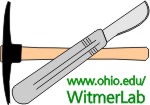- News & information
- About
- History
- George V. Voinovich
- George V. Voinovich Collection
- Calendar
- How to Find Us
- News
- Archives
- Photojournalism Fellowship Project
- Photo Essays
- Current Fellow
- Previous Fellows
- Reports and Publications
- Archives
- Students
- Prospective
- Center for Entrepreneurship
- Environmental Studies
- HTC/Voinovich School Scholars
- Master of Public Administration
- Current
- HTC/Voinovich School Scholars
- Center for Entrepreneurship
- Environmental Studies
- Master of Public Administration
- Alumni
- Contact
- School Leadership
- Strategic Partners Alliance
- Ohio University Public Affairs Advisory Committee
- Ohio University Public Affairs Advisory Committee
- Faculty and Fellows
- Faculty
- Visiting Professors
- Voinovich Fellows
- Professional Staff
| Lawrence M. Witmer,
PhD
|
 |
The Skull of Majungasaurus , a Predatory Dinosaur from the Cretaceous of Madagascar |
Common Language Summary
A dramatic look into the head of a unique predatory dinosaur.
A combination of exceptional fossil preservation and high-tech
3D imaging allows a remarkably detailed investigation of the
skull of Majungasaurus
, a medium-sized theropod dinosaur
collected from 68-million-year-old rocks in northwestern
Madagascar. Majungasaurus
was formerly known as Majungatholus
.
The fossil skull bones are well preserved,
undistorted, and disarticulated, allowing them to be examined
from all sides. Also, many of the bones were subjected to CT
scanning and advanced computer visualization, which not only
permitted a view of the interior structure of the bones but also
allowed the reconstruction of a number of soft-tissue features,
such as blood vessels, nerves, air sinuses, and aspects of brain
and inner ear structure. This unusually rich source of
information reveals a lot about the fleshy head
of Majungasaurus
and not just its bony skull
. The skin
of the head was thickened in areas and so tightly adhered to the
underlying bone that much of the bone surface is extremely
roughened (in fact, this rugosity probably reflects ossification
of the deepest layers of the dermis). The bones along the top of
the skull (nasal, lacrimals, frontals) are not only roughened,
but also bear evidence that they may have sported ornamenting
scales or hornlike structures. At the same time, these bones are
basically hollow, being filled in life with large paranasal air
sinuses. The brain cavity, as well as the brain within, was
quite small and simple. Indeed, Majungasaurus
was not a
clever animal, but rather a powerful one. Its skull structure
indicates large jaw muscles, a powerful bite, and a sturdy skull
and neck structure, such that Majungasaurus
was perhaps
capable of dispatching its prey using the unusual technique of
biting-and-holding (perhaps even suffocating its prey), followed
by forceful extraction of large chunks of flesh.
This project was funded by grants from the National Science Foundation .
Contact Information:
(740) 593–9381 | Building 21, The Ridges
Ohio University Contact Information:
Ohio University | Athens OH 45701 | 740.593.1000 ADA Compliance | © 2018 Ohio University . All rights reserved.





















